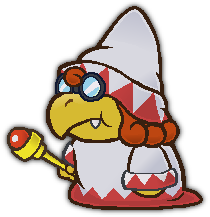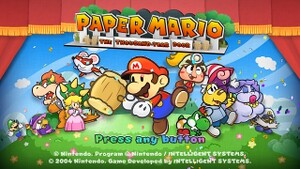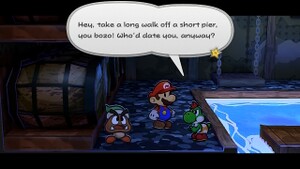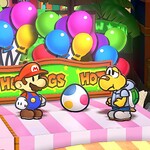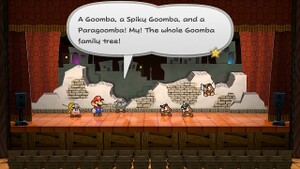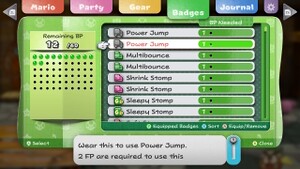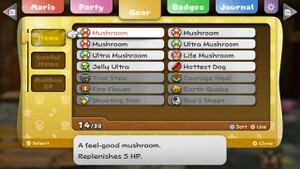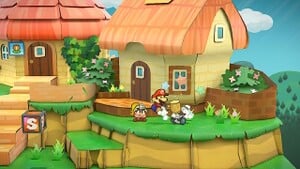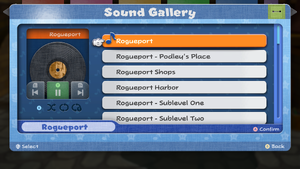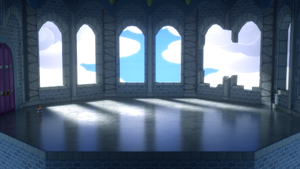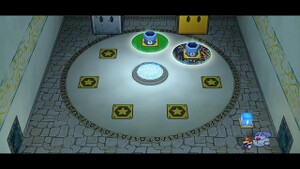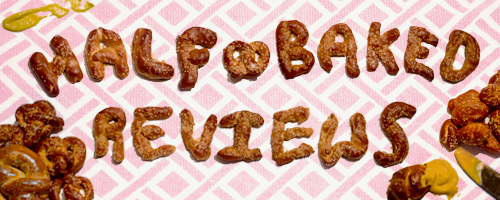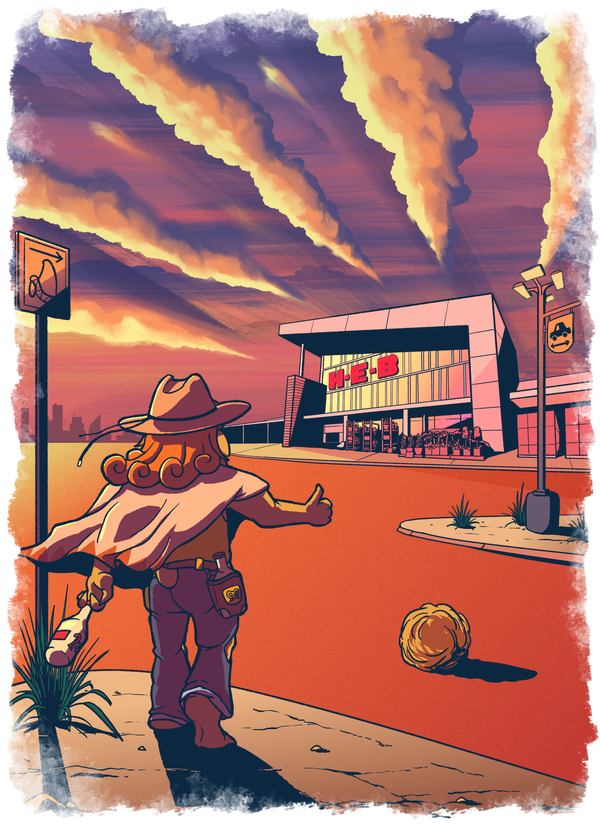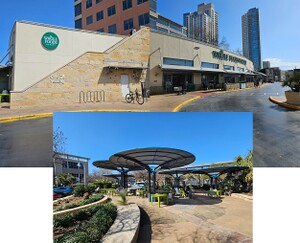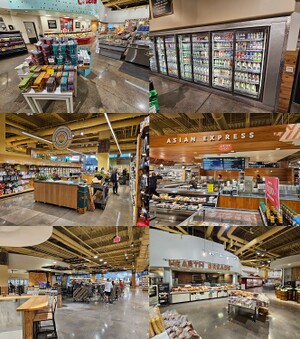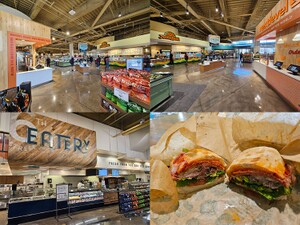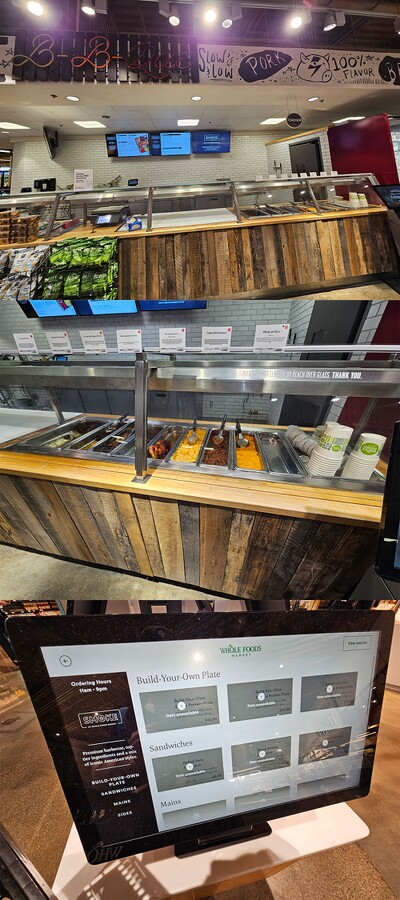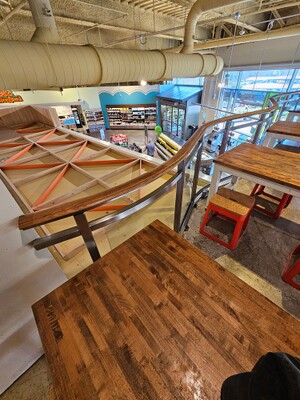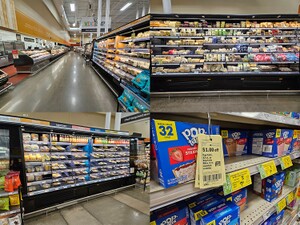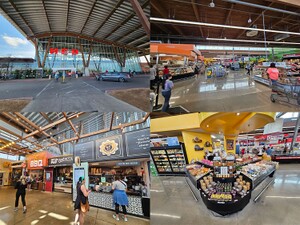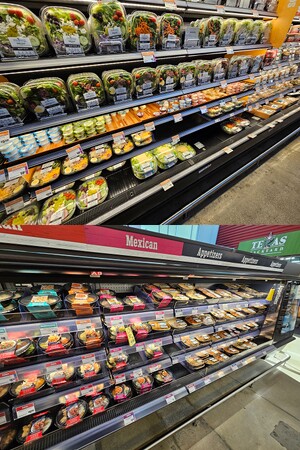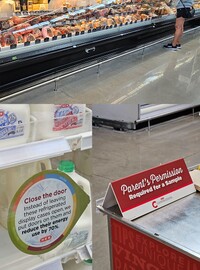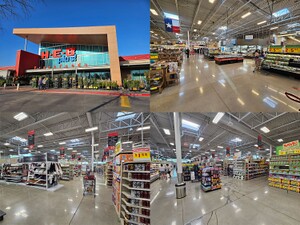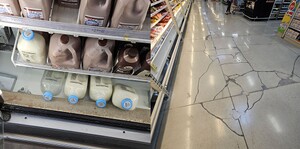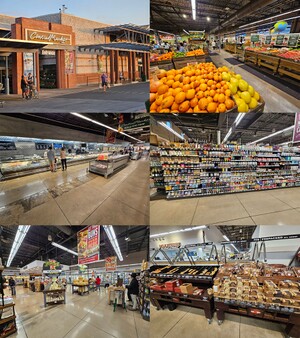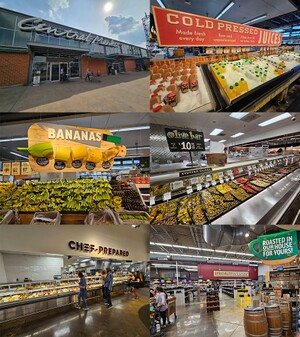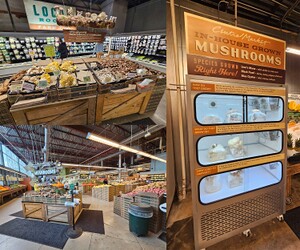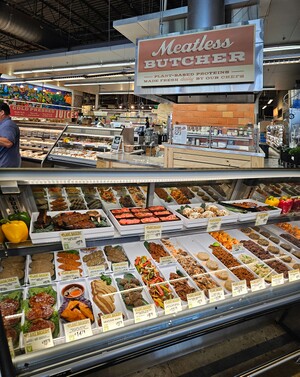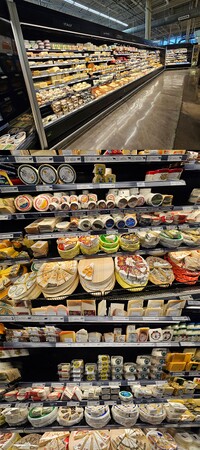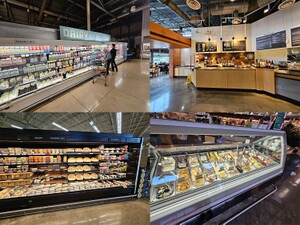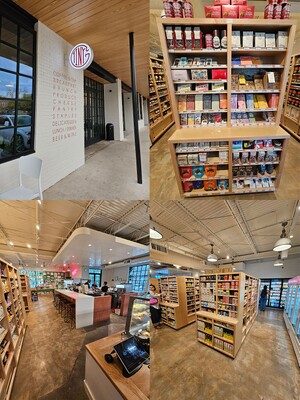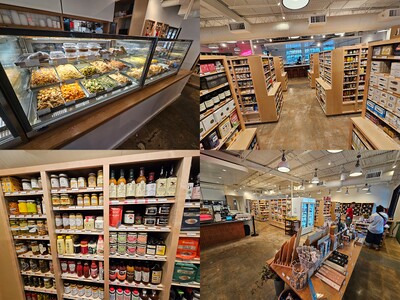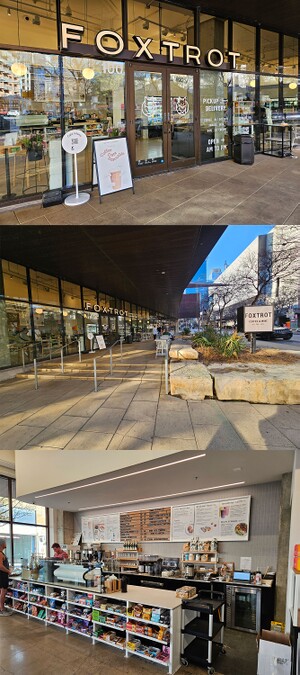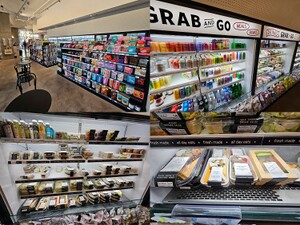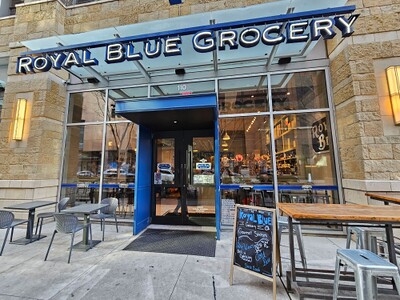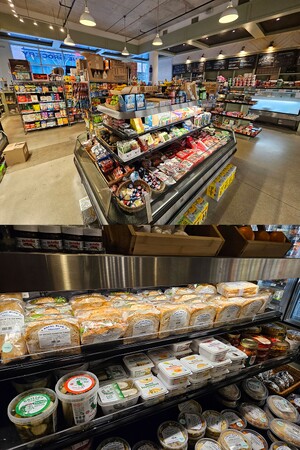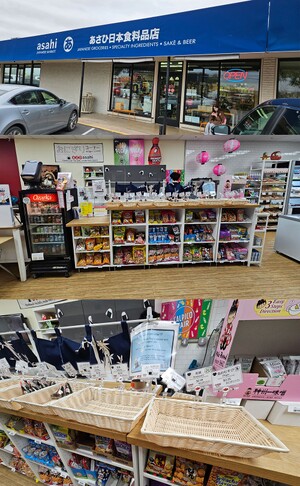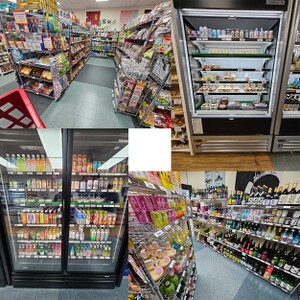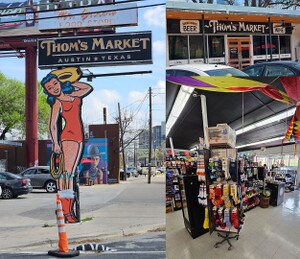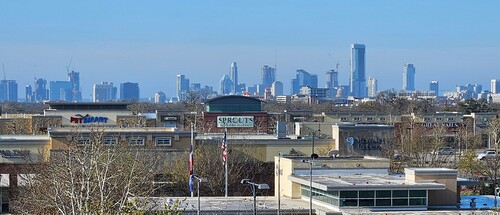The 'Shroom:Issue 208/Critic Corner
Director's Notes
Welcome to July! A beautiful month where not only do I get to celebrate my birthday, but it's when July 4th ends and there's no real major holiday between now and Halloween so all of the stores start carrying spooky stuff!!!!! Our sections this month are long enough to carry you through from now 'til then, so start reading and soon enough it'll be the season!
Thank you for voting Half-Baked Reviews as June's Critic Corner Section of the Month!! Be sure to give your love to all of our sections here, and give a shout out to our writers whether in chat or in their forum threads dedicated to their sections. Be sure to vote vote vote!
And now for my regular announcements: We've decided to implement in Critic Corner something similar to News Flush over in Fake News, where no formal sign-up application process is required for one-time or limited sections. From now on if you just want to send in a single review for something you just read, watched played, tried, whatever, you just have to send me your review privately either to me directly in chat, or in a message to me on the forum at least one week before each 'Shroom is to be released! There's no commitment or obligation to provide a full monthly section (although you absolutely can shift it into one if you so choose), just send us your thoughts on a thing and we'll feature it here! If you have any questions or curiosities about this, please feel free to ask!
As always, if you would like to help Critic Corner, we always have openings for more writers! You are free to write for sections such as Character Review and Movie Review, or really anything you'd like to do! There's no pressure to have a huge section; they can be shorter and concise! The application process is very simple, starting with reading the Sign Up page, and sending your application to Meta Knight on the forum. Any idea you have is welcome, and if you have any questions or need help signing up, please feel free to reach out to myself or other 'Shroom peeps!
Section of the Month
| CRITIC CORNER SECTION OF THE MONTH | ||||
|---|---|---|---|---|
| Place | Section | Votes | % | Writer |
| 1st | Anton's Half-Baked Reviews | 17 | 60.71% | Hypnotoad (talk) |
| 2nd | The Mariospective | 9 | 32.14% | Goombuigi (talk) |
| 3rd | 'Shroom FM | 2 | 7.14% | MCD (talk) |
Super Ninelevendo Entertainment Reviews
Written by: Ninelevendo (talk)
Growing up in the Wii era, Paper Mario: The Thousand-Year Door was a game that I never had much exposure to, but had always heard about with high regard as a bit of a cult classic. Anytime I saw it, it always looked kind of surreal; the artstyle, the characters and gameplay had a distinctly different flavour than that of a typical Mario game. I tried the rest of the Paper Mario games out searching for that seemingly mythical experience, but Super Paper Mario and Sticker Star weren't quite able to live up to the legend that TTYD had become. I did end up quite enjoying the original Nintendo 64 Paper Mario, and knowing that TTYD was a bigger and better sequel had me excited when I finally got around to buying it off eBay several years later. And for all the praise and high regard TTYD got, I was… underwhelmed.
Don't get me wrong, I still love The Thousand-Year Door, it isn't a bad game by any means. By all accounts it's a great game overall and a fantastic introductory RPG that anyone can play. However it isn't without its faults, and is overall quite similar to the original game. While there were certainly improvements to the graphics and gameplay over the original, many other elements seemed copied over or even inferior, resulting a game that is only a little better than its predecessor at best or slightly worse than the original at worst.
Naturally that isn't the whole story, and with the game receiving a new coat of paint with the Nintendo Switch remake, I feel now is a good opportunity to take a deep dive into the inner workings of TTYD and see what makes it such a beloved game by the general fanbase, as well as somewhat divisive among the quieter minority. I'll be reviewing the Switch version, however gameplay-wise the remake doesn't change a whole lot about the original game, so the majority of what I say in the first section will apply to both the original and the remake, and any remake specific comments will be noted as such.
Before I get into the review, I do want to give a general disclaimer that everything here is all my opinion. It's quite likely that as a reader, you yourself won't agree with everything that I say here. And that's completely fine! Having different viewpoints is what makes us unique. These are merely my takes on certain aspects of the game, and I hope you at least enjoy reading them, even if they're different from yours.
Okay, that's enough waffling about myself, onto the certainly-not-paper-thin review!
Paper Mario: The Thousand-Year Door
First and foremost, The Thousand-Year Door isn't your standard run and jump Mario platformer. Instead it's a Japanese-style RPG, featuring all the typical elements of the genre; turn-based battles, health points, equipment and an emphasis on dialogue and storytelling which set TTYD far apart from other games in the franchise. Managing your resources, preparing and strategising for battle and navigating through puzzles in the overworld make up the majority of the gameplay, with some light platforming sprinkled in for the usual jumpman flair.
Turn-based battle systems by nature can be somewhat repetitive and monotonous, so most RPGs keep things moving by placing a heavier focus on deep storytelling and fleshing out characters. TTYD is no exception, offering much more than a basic "Bowser kidnaps Peach" plot, featuring numerous antagonists, allies and side characters that are unique to this game, creating a wholly original setting within the Mario universe. It's for this reason that a lot of people enjoy this series and is a big part of what makes the Mario RPGs special for many, so contrary to my usual tradition of starting reviews by looking at gameplay first, I'll instead begin by diving into the story and characters of TTYD.
Chapter 1: Story and Characters
Story
From the first turn of the proverbial page, TTYD introduces the player to an intriguing mystery of the treasure of the titular thousand-year door, and throws Mario into the unfamiliar setting of Rogueport, a run-down port that's far cry from the usual royal castle or lush green landscape found at the beginning of a typical Mario adventure. It's made immediately clear that TTYD has a completely different vibe to any other game in the franchise, with NPCs acting unfriendly towards Mario, gang fights happening in the street and townsfolk swindling each other left and right. The plot itself varies a little bit by featuring a new villain, Grodus and his army of X-Nauts, including the frequently appearing Lord Crump, who are after the Crystal Stars, with Mario racing to retrieve them first to obtain the legendary treasure beneath Rogueport (but yeah, you still also need to rescue Princess Peach). The mysteries surrounding the plot at the beginning of the game are, while simple, still legitimately interesting and provide ample reason keep the plot going even if your ultimate goal isn't fully realised yet.
With that being said, the complexity of mysteries in the plot aren't exactly equal to an Agatha Christie novel. I won't go into spoilers, but the mystery of the thousand-year door is more or less answered about halfway through the game and the plot for the rest of the game is essentially a macguffin fetch quest until the final boss. Grodus' motivations and moral code are practically never addressed outside of one throwaway line of dialogue and he ends up feeling like nothing more than a Saturday morning cartoon villain, with the rest of X-Nauts being nothing more than incompetent goons. Obviously as a Mario game, TTYD is still a series aimed at a younger demographic that everyone can enjoy, so the plot and themes might never be as mature or layered as those found in other games like Final Fantasy or Persona, but having these elements be as basic as they are leaves the overall plot pretty mediocre and makes the better parts of the story feel like a bit of a waste.
In addition to the overall plot, each chapter provides its own self-contained story that Mario will need to jump into in order to find the next Crystal Star. These vary all over the place, from a swashbuckling voyage to find a pirate king's lost treasure to an Orient Express style quiet train ride-turned murder mystery. None of these stories relate to the main plot in any significant way, but they do provide some interesting dialogue and scenarios that keep chapters entertaining from moment to moment. With that said, not all of them are super interesting, and some are definitely much better than others. I found the seedy mysteries of the Glitz Pit to be one of the best parts of the chapter and the prank that developers pull on you at Creepy Steeple never gets old. Meanwhile Pennington's Sherlock Holmes parody act of doing nothing but say "Just as I suspected!" after getting the solution to a mystery completely wrong was annoying enough for me to feel the need to write a whole sentence pointing out how much I dislike it. Regardless, the chapter stories along with some additional side-stories in Rogueport help fill in the gaps when the main plot isn't moving and are a fun addition overall. Some might even say that conclusion was a rudimentary deduction. (argh)
Similar to the original Paper Mario, the end of each chapter begins an interlude with Princess Peach showing her story as she is being held captive, along with an additional Bowser segment immediately after, both of which allow you to play as their respective characters. The Princess Peach segments can be a little slow and dialogue heavy, however they serve as an essential part to the story and really allow Peach to be a useful character on her merit and as a result the first two Paper Mario games are probably the only two games where I actually care about Princess Peach, which is quite an accomplishment. The Bowser sections on the otherhand feel like a bit of a drag, as Bowser's story is almost completely irrelevant to the events that take place in the game. Most of the silly "Bowser is a doofus" dialogue feels unnecessary and ends up being a bit draining, especially right after doing a dialogue-heavy Peach segment. At the very least the actual Bowser gameplay, being a small 2D platformer segment parodying the original Super Mario Bros., doesn't take too long, but I don't think that's really a compliment.
Partners
A few characters decide to team up with Mario throughout his treasure hunt, referred to as Partners. These characters also help out in battle and have various abilities that allow you to reach new areas, such as Koops being able to reach faraway items with Shell Toss. Each partner has their own story and motivations for joining Mario, such as Goombella being an archaeology student studying the legend of the thousand-year door. Some partners get more story than others, but pretty much all of their side stories become solved or irrelevant after joining Mario's party, and it would have been nice if their character growth continued throughout the game, but considering that the whole point of partners is the ability to choose which one you want to use at any given time it would probably be a bit too much to ask for without some kind of compromise.
As Mario is a silent protagonist in this game, the partners also do the majority of the talking from the protagonist's side, which results in unique dialogue depending on who you decide to have out during cutscenes or character interactions. Goombella for example will give somewhat sassier responses compared to Koops, who's more timid and unsure of himself. This makes your choice of partner feel a little more personal and can help you to connect better with a partner that you might like. I generally liked having Goombella out for most scenes since she felt like she had to most investment in the quest for the crystal stars and quippier dialogue, and that choice did make the story feel a little more personal.
For a lot of people, having unique story and various different characters is one of the most important parts of what makes TTYD special and enjoyable. And personally… I'm not one of those people. Generally with video games, I prefer gameplay first, and everything else comes second. That's not to say that I don't appreciate it a all, I will usually still follow things closely and try to understand as much of the story and characters as possible, but most of the games I play tend to fall short of having any gripping plots or layered, relatable characters, and TTYD isn't one of the exceptions. There's certainly some merit in having a unique plot and using original characters to enhance the overall experience of the game, and it is nice that it isn't a basic Bowser kidnaps Peach rehash, but it's also not going to be the main reason that I would recommend the game to anyone. For people who like that kind of thing, TTYD is perhaps the best Mario game out there for an original story and characters, but for me, the reason I love TTYD is its unique battle system. Hey, it's almost like I'm trying to find a good segue into the gameplay segment…
Chapter 2: Gameplay
Battle System
As a spiritual successor to Super Mario RPG, the original Paper Mario combined turn-based combat with real-time action commands to create a unique battle system that rewards both strategic thinking and skilled reflexes in a way that very few games have copied. It's quite a fun system and keeps battles engaging as you can't quite get away with mashing the A button like in some other RPGs, as correct timing on both offence and defence is (the?) key to victory. It also keeps things accessible by keeping damage numbers low and easily calculable, with attacks generally ranging between 2-6 damage and standard enemies' HP rarely going above 20.
TTYD continues in the footsteps of its predecessor and expands many of its original concepts in various ways. There's a quite a few things to list; Partners now have HP, can use items and can be placed in front of Mario. Enemies can hold items and badges, as well as attack both Mario, his partner or both at the same time. Upgraded boots and hammers give Mario a new attack by default. Duplicate attack badges are now more readily available and can now be stacked to increase their attack power at the cost of more FP. New partner badges make it possible to equip badges that affect Mario's partner instead of just himself. Stylish commands can now be performed to increase the amount of star power you receive from attacking. A harder to perform guard called the Superguard can now be performed to completely negate all damage from an attack while also dealing 1 damage back to the attacker. Mario's level can now be increased beyond the Level 30 cap of the original up to Level 99. A random bingo will sometimes appear, giving you a chance to restore HP, FP, Star Power or even all three (or lose a percentage of all three!).
Perhaps the most notable and immediately obvious change is that the battle arena is now set on a stage, complete with a live audience of NPCs, both of which can interact with the battle in various ways. Stage props can fall over and damage both Mario and enemies if not blocked, the audience can throw useful items to Mario or even show their disapproval by trying to throw harmful items to hurt Mario or his partner, which can be stopped by responding in time with a button. The size and type of NPC is also directly proportional to the amount of Star Power that you earn, affecting how often you can perform special moves, obtained by collecting Crystal Stars.
The thing with all of these changes though is that almost none of them are necessarily an improvement over the original, rather just different or arguably worse. Partners having HP does flesh them out more and give you another resource to manage, however only Mario's death will result in a game over, making their health much more expendable and essentially unimportant. Enemies holding items and stage hazards can completely mess you over by immobilising you or dealing just that one extra damage that you weren't prepared for and killing you. (My only death in the remake was from the Dark Bones miniboss holding an Ice Storm and freezing me with nothing that I was able to do about it… I'm still salty.) Stacking attack badges is generally never worth it since the FP and BP cost usually outweighs the small attack increases, and I personally would have preferred if the stronger attack badges like Mega Jump or Power Quake had returned instead. I would say that overall TTYD's battle system has more fun options than the original, but conversely can also be more frustrating.
The simplicity and accessibility of Paper Mario's battle system is also what leads to its downfall, as once you've worked out the game's systems and how to optimise them the difficulty plummets. With absolutely massive numbers you can get from stacking damage increasing abilities from things like Power Lift and multi-hitting attacks like Power bounce, you can shred through basically anything, resulting in the game becoming incredibly easy. Superguarding can completely trivialise enemies with easy attack patterns even further to the point that they don't even drain any resources to fight at all. Add in the multiple accessible healing options and you're left with very little to challenge you, presenting almost no risk of ever actually dying, making replays a bit boring without some kind of self-imposed challenge.
The final few levels of the Pit of 100 Trails do at the very least provide a decent challenge, and is usually where I have the most fun engaging with TTYD's battle system, but it's a comparatively small section when compared to the rest of the game. A hard mode of some kind would have been greatly appreciated, and I'm especially disappointed that the remake didn't include one when it had the chance to. Self-imposed challenges are still possible of course, but for them to be truly difficult usually involves cutting out a lot of options which doesn't necessarily make the game more fun. On the whole TTYD provides enough resistance for a first playthrough to be fun and not too easy, but once you start to take it any further it loses almost any semblance of challenge.
Badges
Easily my favourite part of the battle system and probably the whole game in general, Badges act as the Paper Mario equivalent of equipment that Mario can use to alter his stats or gain access to new moves. While only a few are available at the beginning of the game, more become available as you progress, along with the ability to equip more if you decide to upgrade BP when leveling up. One of largest differences compared to many other equipment systems in RPGs is the fact that badges are completely customisable; there's nothing stopping you from completely removing your current badge setup for an entirely new one whenever you're outside of battle, granting a lot of flexibility for adjusting your strategy or experimenting. Want more power? Done. Come across an enemy with high defence? Equip Piercing Blow and destroy them in your next battle. Badges allow for constant adjustments and brainstorming for new strategies that I just love.
The variety of attacks that Mario can equip or remove at the moments notice keeps battles varied, particularly from chapter to chapter when the enemy layouts become weaker or more resistant to different moves. A few badges offer more utility focused effects, such as reducing the FP of moves or allowing Mario to jump on spiky enemies. Combining the various badges leads to a variety of playstyle options, which in my opinion is the most fun part of TTYD's combat system.
Granted, it's not perfect. Some badges are better than others, and… actually scratch that, most of the good badges are so much better than the rest that the selection of worthwhile badges can become pretty small once you've learnt which badges are effective and which aren't. Combined with the games' relatively low difficulty, working out the optimal badge setups can make battles a cakewalk, but it can at least still be satisfying to see your planning pay off at the very least. You could challenge yourself by limiting which badges you decide to equip, but again this isn't a perfect solution.
Since I have nowhere else to put this, I may as well mention that TTYD has decent variety of items that can be found or bought as well, ranging from the standard health-restoring Mushroom and damage dealing Fire Flower, to a Sleepy Sheep that summons a herd of sheep to put enemies to sleep or a Shooting Star which pelts all enemies with a meteor shower. I personally don't like using items in battle much myself as I'd rather rely on something more consistent to deal with enemies, such as badges, and generally avoid using them to challenge myself, but the option's always fun to have. Maybe newcomers would get more use out of them, not really my area of expertise. There is however fairly large variety of recipes that can be made, and it can be fun to see what combination of items can lead to new dishes. Completing all recipes is considered part of 100% completing the game, and while the journey to collect all the items needed to make all of the recipes can be a bit tedious, there's a certain zen-quality to the min-maxing monotony of it all that I do weirdly enjoy.
Level Design & Abilities
It wouldn't be a Mario game without some form of platforming and TTYD's level structure leans into this about as much as you would expect it would. Jumping on platforms and hitting blocks are still a key part of the game, but much like the original Paper Mario, every location is interconnected in some way with no level select screen in sight. Some light puzzles involving Mario or his partner's various abilities also come into play, giving you plenty to do between battles.
Unfortunately however the level designs themselves are probably one of the weakest parts of the game. The majority of areas follow a very linear left-to-right path, resulting in the game sometimes being referred to in a slightly exaggerated (but still fairly accurate) manner as a "hallway simulator". This issue becomes especially apparent with the amount of required backtracking the game throws at you, as apparently walking through a linear corridor once isn't enough. Every chapter has at least one instance of forcing you to walk back through an area that you've already been, which will generally respawn enemies and leave you fighting the same enemy loadouts again if you don't decide to just avoid them entirely. This wasn't nearly as much of an issue in the original Paper Mario which had a number of larger areas with multiple levels or directions to go in, so it's a bit of shame that the sequel wasn't able to match that level of quality.
A lot of areas feel very similar to the original game as well. Chapter 1 starts with grasslands, featuring to a village full of Koopas and finishing with a boss fight in a castle, which is a sentence that could be referring to either game. Chapter 4 has a similar spooky theme to Chapter 3 of the original. Chapter 5 has Mario setting sail to a faraway tropical island… like Chapter 4 of the original. Both Chapter 7s feature an ice setting. Chapter 8 is a final dungeon crawl through a huge castle. Not every chapter feels like a repeat of something that the original did, Chapter 3 and 6 feel wholly unique in that regard, but the repeated themes with only minor variations does make TTYD feel more derivative than it needed to be, and the generally worse level designs only add salt to the wound. Unfortunately the Spin Dash from the original doesn't make a return either which leaves movement feeling somewhat slow and uninteresting, another thing would have helped making travel less monotonous.
One thing that I do like more about TTYD however is the introduction of Paper abilities to Mario's traversal options. The abilities themselves are also fairly fun and thematically fitting, turning Mario into a paper plane or allowing him to fit through small gaps by rotating 90 degrees. These essentially act the same as some of the partner abilities from the first game without needing to overload you with partners like the original did, which I think is a noteworthy improvement.
Chapter 3: Music
The original TTYD's music is pretty good, but I wouldn't go as far to say that it's amazing. There are some standout tracks like the main hub Rogueport's theme or Doopliss' Battle Theme that are hard not to like, however the vast majority of soundtrack generally ranges between good to merely serviceable, and in rare cases even a bit grating (looking at you, The Great Tree). The original game deliberately uses a pretty odd soundfont that emphasises the wackiness of the game's world and characters, which I think it works pretty well. Most of the more atmospheric tracks in the game like Rogueport Sewers and the Excess Express at Dusk have this chill Lo-Fi kind of vibe to them that I quite like, and this is where I feel the music of game is at its strongest. The rest of the soundtrack doesn't stand out too much in comparison, there's a few battle themes that are quite good but I don't think anyone's going to be petitioning for Intelligent Systems to release a greatest hits vinyl over this game in particular.
The Switch remake on the other hand completely redoes the soundtrack in the same style as Paper Mario: The Origami King, which in my personal opinion is one of the best soundtracks in any Mario game ever, just slightly behind the fully orchestrated soundtracks of Super Mario Galaxy or Mario Kart 8. They use a lot of distorted guitars resulting in some very metal sounding tracks, which is something that I personally love. So having the chance to completely redo TTYD's soundtrack with the same sound team as the previous game, you'd think that it would result in an equally fantastic soundtrack, but honestly… it's a bit mixed.
To start with the positives, most tracks on the game get an immediate upgrade purely from being an orchestrated performance as opposed to computer generated sounds, and purely on that basis I feel that the new overall soundtrack is objectively better. Each chapter now has its own battle theme to match the theme of the area, which is always great. If anything I was disappointed to not here the original rendition as much, which is not a bad complaint to have. Quite a few tracks have been extended with new melodies that usually add something meaningful to the track, which as also quite nice. Some others feel like they were just done as a requirement and don't necessarily improve the track in any way, but even at worst they're not really a negative addition either.
The music in general has also become more dynamic, with different layers being added or removed depending on the situation. Some areas that have multiple levels, such Hooktail's Castle or Rogueport Sewers, have new layers added to the music depending on how deep you go into the area, which is a really neat addition. Idling in battle for a little while will remove the lead instruments, shifting into a "thinking" version of the track, similar to The Origami King. These things lead to the soundtrack adding much more to the experience overall, and is one of the most notable changes from the original after graphics.
However a lot of my favourite tracks from the game are changed in ways that I don't think suits them quite as well as they could have. To list some specific examples, Doopliss' theme changes the sound of the lead synth to something different that I can't quite describe, and it sounds just a bit wrong compared to what I'm used to (although the extension to the track is fantastic). Cortez' Theme now has this new death metal-like rhythm added to it which I think is great, however the original lead instrument gets almost completely drowned out by the percussion due to some changes in how it sounds, which ruins some aspects of the track. Rawk Hawk's theme is perhaps the one that I was most disappointed in. The original track goes for high-energy, pro-wrestling rock kind of style and you'd think it'd be super easy for a sound team that obviously has a lot skilled guitarists to improve on, but instead the new version replaces the faux-guitar with a synth and has changed the overall feel into a more sinister, back-hand cheater theme instead. Both are valid ways for a musical theme to represent an interpretation of the character, and the new theme isn't bad in its own right, but it just doesn't match what I was hoping for.
Some parts of the game have also been changed so much that they have a completely different feel to the original. Riverside Station from Chapter 6 in particular went from a being quiet, solitary area to a bombastic 1900s Wild West big band hootenanny where the acoustic guitar and brass instruments urge Mario to shoot first. The new music itself is honestly pretty fantastic, but the severe tonal shift in the style of music completely ruined the vibe that I enjoyed from that area in the original. Glitzville has also received a bit of a musical switch up, with some themes now using oriental instruments to match the Asian architecture found in the area. I didn't mind this change as much, but I imagine some fans of the original game might not feel the same.
So overall while I do think the new music tracks are a general improvement over the original games' soundtrack, I also don't think the new soundtrack was quite able to be definitive replacement, which might mildly annoy some fans of the original game. There is an option to replace the music with the original versions with a the "Nostalgic Tunes" badge available at the start of the game, but it doesn't replace any of the new tracks like the partner themes or the aforementioned Riverside Station theme, so it isn't a perfect workaround either. I still liked the new soundtrack enough to not want to replace it anyway, and I'm sure I can live with having two versions of the soundtrack that I like for different reasons.
Chapter 4: Remake Specific Changes
When it comes to video game remakes and remasters, there's a lot of confusion between what qualifies as each due to a lot of them not changing much of a game outside of graphics. Despite sharing the same title, the Switch version is definitely a complete remake; different engine, different code, different graphics and different music. However the question with remakes is how far should they go with changes? Should they stay as close to the original as possible and be a near 1:1 remake? Or should they completely reimagine the game's ideas and recontextualise them for modern gaming standards? There's no clear answer to that question, as how much a game should change varies based on the game being remade and what the vision of the remake is.
In the case of TTYD, not a whole lot needed to be changed, the original was a GameCube game after all which is in the era where most modern gaming conventions started. Even the graphical style of the original held up quite well due to the simpler character designs and cartoony artsyle, to the point that I feel as though a simple remaster of TTYD that upscales the textures would have still looked really good and been a perfectly acceptable way of playing the game on the Switch. Other GameCube games have already gotten similar treatment, Super Mario Sunshine for example got pretty much exactly that with the Super Mario 3D All-Stars release and it looks great. Even Metroid Prime and Pikmin 1 + 2 all got remasters, with Prime clearly being touched up a considerable amount to look great even compared to other Switch games. So when the TTYD remake was revealed, it had me wondering why they had decided to give the game a full blown remake instead of a typical remaster. The benefits of a remake usually come from being able to change things from the original game to improve the experience, so what did TTYD get?
Graphical Changes
Firstly, there's the graphics. The differences between the two don't look super obvious if you were to compare them one at a time, but it is still a fairly large difference. The remake obviously looks a lot better with higher quality sprites/textures and the resolution bump, but perhaps the biggest difference that couldn't be achieved with a simple remaster is the new lighting. Areas now have more realistic lighting and shadows that do look quite nice. The floors and walls now reflect things around them similar to how gloss paper would and was honestly the one thing I was never able to stop noticing every time I jumped back onto the game.
The artstyle itself has also been adjusted to be more papery, as with all Paper Mario games since Sticker Star, with pretty much everything in the game looking like it's made out of some sort of paper or cardboard material. I'm personally a fan of this style and think it looks pretty unique. Thankfully in the context of this remake the paper aesthetic has been implemented tastefully and hasn't completely changed how the game looks, rather blending the two styles in I way that I would consider to be pretty much perfect. One thing that I always loved about the original game was the smooth animation of the characters, which was made possible by separating all the parts of each character and having them move separately, something that later games didn't keep as they instead went back to using full sprites, along with thick white outlines. Here, they've kept the character models similar to the original, which I'm very pleased about, and instead of adding the white outlines found in Color Splash, they've given the characters just a little bit of thickness that has been left white to replicate cut-out paper. It took me a little while to get used to at first, but I eventually came around to it and think it's probably the best style we've seen in a Paper Mario game to date. The remake also added a bunch of new facial expressions for most characters, which really goes a long way in making the characters feel just that bit more alive.
Speaking of smooth animation however reminds me of the one slightly-less-smooth elephant in the room; the Framerate. The original game ran at 60fps, while the remake runs at the perfectly acceptable but still objectively worse 30fps. Before the game released I was worried that it might make character and particularly battle animations much slower and worse, but after playing the game, I can say that it really isn't that bad. It still takes me a few seconds to get used to the slower framerate every time I boot the game up since I'm so used to the original, but afterwards it stops bothering me and the game still runs, plays and looks fine. Jumping back into the original after playing the Switch version also gives a similar feeling of whiplash with how much smoother it is, and I really would have preferred if the remake could have been at 60fps instead of giving us glossy floors, but it's not the end of the world and the Switch version is still a completely fine way to play the game.
Unfortunately there's a few other things that make the remake feel more sluggish, and the big one is the text speed. The original game allowed you skip through text incredibly quickly to the point that you could skip a textbox in a quarter of a second, meanwhile the remake matches what the more recent Paper Mario's do by only letting you slightly speed up the text, making dialogue sequences take muuuuuuuuuuuuuuuch longer. It's likely not going to be big deal for most who are playing for the first time and would want to read the text anyway, but for people who don't care about the dialogue or for anyone who's replaying of the game and had already read the dialogue the first time around, it's a huge annoyance and honestly makes me less likely to replay this version of the game if I've already played either version of TTYD recently. The sounds made when text appears on screen has additionally been changed to match the characters that are speaking in a somewhat Banjo-Kazooie-esque manner. It's slightly on the annoying side, but not enough for me to actually complain about it. It'll probably annoy anyone else that can hear you playing the game, but that likely wouldn't be any different with the original text noises anyway.
Battles also feel a bit more sluggish and drawn out, thankfully not because of the attacks being longer, but rather the inability to quickly select things in the menu, being forced to wait for the star gauge to fill up before the next turn can progress and not being able to skip the end of battle Star Point collection sequence. Those last two in particular were a continued annoyance as they noticeably made battles and turns end much later than they do in the original, particularly when leveling up, and considering how common battles are this stacks up over the course of the game to make battles feel just that bit less snappy than before.
Quality of Life Upgrades
Not everything about the remake is slower or more tedious however, as they've made a few quality of life changes that make certain things feel much better. A new partner ring allows you to switch partners without bringing up the entire pause menu (although honestly it's only very slightly faster than before, the visual change is probably the biggest difference), multiple items can be selected at once in times where it's relevant, shops now show you how many items you have in your inventory without you needing to open the menu, the hammer can now be swung in 360 degrees as opposed to the 2 directions from the original, cutscenes that have already been viewed can be skipped, etc. These are all pretty small changes but they're all welcome ones that cut down on the small inconveniences of the original.
The biggest quality of life additions are the ones that greatly reduce the amount of backtracking involved, which mostly apply to the two most lamented parts of the game: the Creepy Steeple trail and the General White quest. The original game required you to go through the path between Twilight Town and Creepy Steeple a total of 5 times, with the last two being completely unnecessary as nothing changes after the third time. The remake fixes this by adding a pipe that can be accessed after the third time that allows you to completely skip the path, and this is probably the single best change from the remake besides graphics. Another big change is the revamped pipe room in Rogueport Sewers, makes travelling to the different locations in the game much faster. There were similar rooms in the original, however they took slightly longer to get to and didn't have pipes to places like Glitzville or Twilight Town since they had other direct connections to Rogueport, but travelling between them and the pipe rooms still took a considerable amount of time. The new pipe room makes travelling between these places considerably faster and easier, which greatly helps with sidequests and the aforementioned (and mandatory) General White quest, which forces you to travel all over the place. Keelhaul Key also got a new spring that cuts down some of the travel time, which doesn't completely fix the backtracking issue but is still a nice improvement.
Most of the other additions to TTYD come in form of accessibility features, such as a Toad that allows you to practice action commands or a Little Mouser NPC in the Trouble Center that will give you tips on whatever trouble you're stuck on. The ZL button has also been assigned as "Hint" button that will have one of Mario's partners, usually Goombella, give an indication of what you should be doing next. Being familiar with the original game myself, I didn't use these features at all other than to practice the new Power Bounce timing, but I'm sure they'll be a nice feature for newcomers.
So overall, do these quality of life changes make the game better overall to play? I would need to replay the original game again to make a more definitive judgement, but even with all those things in mind including the pretty major backtracking changes, I would only say that they're about equal. The majority of improvements are on things that only come up a few times during a playthrough, meanwhile the slower battles and especially text are a constant source of annoyance that would repeatedly make me wish that the remake worked more like the original instead, compared to the one or two admittedly longer periods of time in the original where I would wish it had the backtracking changes from the remake. Granted, the text issues didn't bother me too much on my initial playthrough of the remake as I hadn't played TTYD in a couple of years and was happy to read the text again, but I imagine it would make the remake much less desirable for challenge runs and I'm not really interested in finding out myself because I feel like I would just end up frustrated.
My final verdict is that both versions of TTYD are completely valid ways to play the game and you'll get the same overall experience with either one. For someone who has never played the game before or is newer to games in general, the Switch version is objectively better due to its accessibility improvements. Whether or not the remake changes enough for owners of the original game to consider it worth double dipping is something that can only be decided by an individual, and as someone in that camp I personally wished that there was a few more changes to improve the game or differentiate it from the original in some way.
End of Chapter
Like the legendary treasure of Rogueport itself, some things can sound better than they really are, and it's only after you investigate through the evidence yourself that you'll find the real value of what's being sold. To me, The Thousand-Year Door's online reputation as "one of the greatest games ever made" seems little overblown. I'm not even sure if it's better than the original Nintendo 64 game, and if anything it's closer to being equal. Maybe releasing around the time that the internet truly started becoming accessible was what gave it such a reputation? Perhaps those who played it at the time were young and hadn't played any other RPGs before?
Whatever the case, in the end I realise that The Thousand-Year Door's popularity doesn't come from being one of the best games ever made, but rather because of its accessibility and ability to introduce many players to a completely different style of game that they've never played before. With a unique battle system and tons of memorable locations and characters, there's bound to something that will stick with you, which by itself is enough for TTYD to justifiably be held in high regard and be a worthwhile recommendation for anyone to play. The remake may not be a completely definitive replacement of the original, but it does provide a more modern and accessible way to play the game, and when all is said and done, maybe that's all that was needed for a new generation of people to fall in love with TTYD like many others before.
My Thoughts on TTYD
Written by: Boo1268
Let me start by saying, I have never played the OG, and I haven't played the remake yet either, but also, I love both games equally! Even though I never played the original like i said, I have watched many playthroughs. So while I can't talk about battles or the actual gameplay itself from a first-hand experience, one thing I can talk about is the storytelling. TTYD is one of many wonderful games in Nintendo's catalog that does a masterful job with how it conveys its story. On a personal note, this is also why it was really hard for me to pick a topic from the game for The Spectral Lens; because there were at least 15 different ideas I could have written about. The game's battles take place within a stage play, and each one has wonderful locations brimming with life. It makes you feel like people have lived in these places, and that there's some history behind them. The funny dialogue and witty banter gives the impression that characters know certain amounts of info about each other like real people. Also, the music. Oh my god the music. It's incredible and for me, the remake's OST is alright but the original will always be my favorite. Finally, the personality of each character you come across, even the most minimal side characters, have a whole lot of personality packed within them. All of them are wonderfully written in this game to the point where you really do care about each of them, and their arcs. Even though I didn't get to experience the game myself, I was still blessed to see it thanks to D-Up 242's Paper Mario the Thousand Year Dub, which has all the characters in full voice acting, before the remake came out! The remake with its Banjo-Kazooie style of character speech perfectly fitting each wacky character was marvelous to see, but I prefer the dub. So to recap, the gameplay is great in both the original and Switch versions (from what i saw), the story throughout the whole game is one of the best story-driven Mario games I've seen in a long time. It still proves to me that Nintendo will continue to make amazing stories for all to enjoy, and they can create awesome things.
Graphic Novel Review
| Superman vs. Meshi, Volume 1 | |
|---|---|
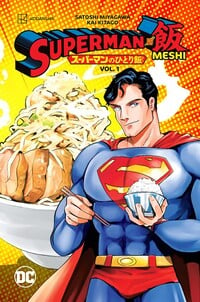
| |
| Author | Satoshi Miyagawa, Kai Kitago |
| Release date | 2023 |
| Genre | action, comedy |
| Pages | 160 |
| Available From | |
Greetings, readers, welcome back to a new Graphic Novel Review! This month, I will be looking at Superman vs. Meshi, Vol. 1!
This one was a bookstore find- I was in one of my local comic shops with a friend while we were walking around downtown and decided to pick up this book on whim. It is a manga instead of a graphic novel, but it’s been a while since I’ve featured a manga here, so let’s dive in!
Superman vs. Meshi is not quite a superhero story. If you’re here to look at super fights and punching bad guys and all that, there’s very little of it here. Rather, this book is about Superman enjoying the food of Japan. I think it’s a quirky little setup- Clark Kent gets an hour for lunch every day from his job, and when he’s hungry, he’ll rip off his disguise and fly over to Japan as Superman to eat at a variety of different restaurants, from noodle shops to sushi bars and even a trip to 7-11. I’ll say it this way: if you’ve seen TikTok or YouTube content of influencers going to Japanese restaurants or convenience stores and trying food, and you like that, you’ll like this, as it’s a lot like that. This is a quick pick-up read- you don’t need to have read 100 issues of a Superman comic book to be able to understand this one, although I can tell it takes place somewhere within DC’s universe as the intro page for the Justice League mentions that Green Lantern has been missing for a while. It comes up a couple times in the story, and I can tell they’re going to build to it in the future, but they never go too deeply into it.
This isn’t an action-based book, so there are no big fight scenes. There’s a small one with some aliens in a later chapter, but that’s about it. Superman is quite the food geek in this book and visits a lot of different places. I think my favorite was the 7/11 chapter- I like to watch content of foodie YouTubers going into convenience stores and seeing at the massive variety of foods they have available to them, so I had an idea of what to expect when Superman lands in Japan a little too late to go to a proper restaurant and he has to go to a 7/11 for lunch instead. There’s a chapter where Superman is trying to decide between a pork bowl and a beef bowl and tries to figure out which bowl is which by looking at the kanji only, and it goes… about as well as you would expect. Aquaman and Batman appear in their own chapters as well, Aquaman’s being at a sushi bar (predictably) and Batman’s starting at a fancy Western restaurant and Superman quickly changing their location. I think my biggest ‘con’ about this book is that it is a manga printed in black and white- when you do a story about food, you lose a lot of the visual appeal of said food when it isn’t printed in color. I get that color printing is expensive, and this is definitely not the first food manga I’ve read that’s been printed in black and white… that being said, it is DC, one of the major comic companies in North America. If anyone could shell out for a manga to be colored and printed in color, it would be them. But that’s my biggest nitpick about the story, so if you’re on the fence about it, don’t let the lack of color discourage you from getting this.
Superman vs. Meshi, volume 1, is a good story for anyone- if you’re a Superman fan looking for something new to read, if you enjoy food content and superheroes, or if you’re a foodie beginner, too. If you want to jump into food content, this would be a good place to start if you’re from the West and want to get your feet wet to see if you like it or not. The entire story is now complete with 3 volumes, so it won't take up too much room on your shelf if you decide to buy it.
That’s all for me this month, readers! Tune in next time for a new Book Review!
Written by: Hypnotoad (talk)
Artwork by: GBA (talk)
Austin - Part 1
Regional Grocery Stores
Ah, Austin, the ‘live music capital of the world’, a beautiful place for me to actively and painstakingly avoid any whams, plucks, or twangs of noise because nothing generates as many horrific thoughts and feelings all at once more than having ceaseless guitar string scratching at artillery fire decibel levels happening 10 feet away from where I’m trying to eat.
It must be stated that this review is not intended to be the end-all of reviews detailing every aspect of these grocery stores, as even though I would certainly love to do that, I quite frankly am not getting paid to do this and therefore do not have the time or ability to dig very deep. What I will be doing, though, is what I think is more useful anyways, at least for me and more for travel information purposes as being a first look and immediate usefulness of these stores. I've selected these nine technically different stores from what must've been over 16 that I can recall checking out during my week in Austin, as they offered SOMETHING different in their format and experience that's worth mentioning in paragraph form. Places like Wheatsville Food Co-Op, Dia’s Market, and Fresh Plus Grocery were alright but just really didn't elicit much complex thoughts from the perspective of some random dude who rode a Lime scooter down the highway to get to them. That’s not to say these were bad stores; some I actually really enjoyed, but maybe I could get a line or two about how they had a good chocolate bar section, or I found some weird milk there, nothing that was so inspiring in a single visit to generate more than a couple one-line comments. They all fell under a collective understanding of typical Austin cultural influence, and I otherwise appreciate their existence and contribution to shelf space and availability as important in this particular ecosystem but otherwise they were just there.
It must also be said that I've taken just about 700 photos during this trip, and I can't quite so easily place all 700 photos here, so if anyone wants to see more just reach out to me and I'll infodump like crazy at you.
Whole Foods Flagship Store
I swear I’m more exciting of a person, but one of the lures of going to Austin was that during my general scoping of which city to visit next I was panning over downtown areas and noticed Austin has the Whole Foods Corporate Headquarters–which makes sense as that’s where it was founded–and nestled right in with it at 525 N. Lamar in downtown is their flagship retail location. Curiosity piqued and nosiness intrigued, I just had to see how prim and proper a location so close to corporate was. Now, I’m not a corporate fanboy and never will be, and I nearly shed a tear when they were acquired by Amazon in 2017 as it promised a sick capitalist pivot alongside whatever optimization features came along, but Whole Foods pretty consistently stocks more local products than even local-only shops do (and while being stored properly and without being expired), and as such it nearly always ends up as a must-see on every trip just to collect what I can.
The retail aisles are designed in a way that promotes wonder and discovery, often weaving around specialty setups and leading you to expanses of unique displays that surprise you, like the bar area as well as their open frozen area, floral, and health-and-beauty options. Perfectly curated endcaps and displays that tells me that corporate upstairs is watching, with heavy placement of parmigiano reggiano in every possible secondary pairing you could imagine that told me both that the person responsible for buying cheese went a little heavy but is also cunning and connected enough to convince other departments to cough up their space. One major gripe, though, is their dairy section is tucked into an awkward narrow alley behind the bar that feels underlit and unequipped to support more than one or two customers shopping and god forbid one of them stands still to look at something. I got over that pretty quickly (though I guess not fully as I made a whole statement), as the narrow barrel shot me out into a much more open seafood area, wine, miscellaneous nonsense, and into produce, to conveniently loop back around to the front of the aisles where my failure to locate the chocolate this entire time led me to frustration. Turns out that they have a lot of their fancy chocolate displayed along the self-checkout partitions in the impulse racks, with their usual expensive chocolate table with an alarming lack of variety plunked in awkward space between specialty cheese and prepared foods likely as the massive wine section is all the way on the opposite side of the store. Lots of variety offered in their other grocery sections like dry goods and frozen, but specifically the three areas I care about most felt woefully underrepresented.
In the back of the store was another large seating area with a bar, with the Asian grill and sushi nearby, and next to a desolate and horrid looking wasteland called Smoke, their barbecue food spot. Despite there being a couple pans out with food in them, there was no worker to be seen and all of the options on their ordering tablet were listed as unavailable, which I’ll add is how a significant majority of all of their available options throughout every venue were. The ordering hours are listed on the tablet as 11am - 9pm, and I was squarely within that as I strolled through the place between 12:30pm and 2pm. What I saw available is a lot of what I already see in their regular hot foods self-service areas, but with more basic smoked and bbq meat options like ribs, whole chickens, brisket, and pulled pork. I’m unsure why the Smoke options were unavailable, as every other review goes on to rave about it being an option, but the food being partially there at all combined with the ghost town vibes leads me to believe significant issues with callouts and staffing that lead to a complete service breakdown that they were unable to reposition or gain control over. I was definitely hoping to try their brisket out to then compare it to other actual brisket restaurants, but, shame to that I guess.
Most Whole Foods locations I’ve been to have some kinda dining hall area that they just cram their little pizza shop, deli, and coffee nonsense into with a few seats lined up against the windows, and never EVER looks very appealing to sit at for any length of time and just generally feels abandoned. However, the massive 80,000 square foot Flagship has some upgraded features, with a whole café and seating area called 6th Street Eatery, here: their coffee area now a whole La Colombe shop (instead of their usual Allegro brand), a JuiceLand, and a Next Level Burger. Despite all of the 3rd party branding, it also looked pretty abandoned with people wandering around curiously but not ever really interacting, and I think this is merely an illusion set against them by their own convenience features as nearly all ordering was to be done on the app or through the ordering kiosks that leave you to just wander around in a purgatory state around the entire prepared food area waiting for SOMEONE to call your name. The absence of lines and deafening quietness emphasized the lack of interest, and introduced an air of nervousness that I could witness in myself and others feeling unsure of ourselves being the only ones approaching the kiosks before just looking around at no one else doing anything before just walking away. Not me, though, I chugged ahead because I didn’t pay for a flight and hotel here just to chicken out with self-service, but I was nearly dissuaded by seeing just how many options were unavailable with pizza, the Cocina, some sandwich options, etc., just really disappointing to have all of these fancy features and barely any of them being up. Even the self-checkout lanes in this area were all turned off–likely due to not having the staff to watch over it–which made me feel weird even being here. What I ended up going for was a sandwich from their own branded in-house deli shop, mostly because it was the only place that had food I was actually interested in and also seemed to be the only one with people at it.
There’s an outdoor seating area that looks cute; gorgeous day out, good view of the scenery and tall buildings, casual traffic and people watching, tourist photo ops nearby, and even more on what’s essentially the store’s rooftop in a courtyard that goes towards the global headquarter’s entrance, but it was just honestly too hot for me to consider dealing with that, so the indoor sitting options were left to choose. The bar area sitting felt way too open, which is good for people watching but also exposed more to people watching you as there’s nothing around to obscure vision like some simple panels or aisle displays. So, upstairs it was, past all of the eating options into a corner that felt so abandoned and lifeless that I truly felt like I wasn’t supposed to be there until I got up there and found like five total tables where a handful of people were sitting and seemed vastly irritated that I had intruded. Incredibly small relative to what I would’ve expected, with abysmal views of some air ducts and wooden paneling that made it look more like I was sitting in the middle of a construction area instead of having a gorgeous view of the shopping area as I’d get from many new Publix builds, but it did provide a level of seclusion in both obscured vision and also with snobby freaks hiding behind their Apple laptops that allowed me to comfortably pull out the SEVERAL bottles of milk I bought to take pictures and consume without further judgment. I sat there for a while, eating my $13 Toasted Spicy Calabrian Sandwich I got from the sandwich shop below, taking in how phenomenally greasy and filling it was coupled with my decision to drink what amounted to nearly half a gallon of whole non-homogenized milk as I prepared to spend the day walking around a sunny and hot city.
Of course, the cheese shop was a destination I had to visit, and I’ll start by saying I was kinda disappointed by it. Don’t get me wrong, it was a gorgeous display, a curved open-air refrigerated display where the cheese is placed on tiers that cascade down in visually natural stacks, pre-packaged cheeses next to whole wheels that had been freshly cut into wedges or cubes by skilled staff, with excellent organization based on cheese type with plenty of information available. But. I was expecting more, wishing for more. This wasn’t too different from any display I’d see at any other Whole Foods, or even any other grocery store that hopes to be called upscale, and was honestly pretty small–especially in comparison to how absolutely massive the store signage above it is. What I’d like to see is more emphasis on the cheese specialists and full service in addition to their standard self-service, with more variety offered in the form of rare and exotic cheeses that are cut, per request, by weight by a skilled monger I’m sure my vision here would be denied in the spirit of wanting to have a more uniform experience between all Whole Foods locations, especially in regards to the difference in training and care it would require, but, for a flagship location that’s located literally in the same structure as their global headquarters in a busy health-conscious city with plentiful other grocery options that easily rival them (and triumph over) fiercely in a way that Whole Foods can’t reasonably argue that they’re the best option for, I would hope that they’d be hope for some extra pizzazz to set them apart, highlight further, become a destination for true gourmands and the curious who had a more curious palate than just taking a photo at the ‘atx’ sign out front before getting a draft latte to go.
Overall the place looked beautiful, well-stocked, ample curation, but wound up being more of a disappointment as it truly felt like nothing special aside from there being more room to walk around. There were a lot of ideas here that likely looked good on paper, in a slideshow in a meeting, but did not have the complete execution of full thought given to make this a truly unique and proud feature rather than what it stands with being the best pressed uniform in the closet. More finesse, more care, most likely more benefits and better treatment is needed to remedy how it doesn’t feel like there’s soul here, with the true answer to that being complete divestment from Amazon.
H-E-B
While Whole Foods is Austin born-and-raised, it’s H-E-B that carries the Texas pride and spirit. It’s hard to review an enormously popular regional chain grocery store–not out of inability, but of scale and depth. I always hear competitive smacktalk with competing regional grocery stores as they expand to new states and locations. For example, there’s roughly 8-11 Publix locations per 10 square miles in Orlando, with a population of about 316k, meanwhile there’s about 2-4 varied H-E-B locations per 10 square miles in Austin, a city with a population of 974k. The simple logistics of this implies that H-E-B stores must be larger to serve higher customer volumes and larger areas than what a Publix would–70k square foot average with the largest 178k square foot, meanwhile Publix stores average at 47k square feet with 82k being the largest–and thus not very comparable in my eyes. What I can fling, though, is that for a store that’s often stated as being synonymous with Texas, it sure is a wonder that not a single location currently exists in Dallas proper, with very few in northern Texas at all, though I’m not sure if that qualifies more as a slight against the city. There’s been a lot of chatter on why this is the case by Texans and more passionate retailer geeks that are out of my league, and I’m thankful for it because now I have a new grocery store forum to keep an eye on.
The first H-E-B I went to was less planned and more because it was the closest place open at 8pm on a Monday that looked like a safe place to stumble desperately to a comfortable bathroom after having eaten more food than my entire digestive system could physically fit while making the poor decision to make an hour long walk back to my hotel. The presence of security, while I understand some credible need, was intimidating in a way that felt like they were an active force rather than passive watchers. Primary example, I stood near the entrance for like 30 seconds while looking at a map of the area on my phone and figuring out where to go next, and the security guard at the door started giving me a really nasty stare that would not get off of me even as I walked away and around other areas, with him physically moving as far away from the door area as he could to keep an eye on me. After getting out of his eyesight, I began to check out the place. The deli has a wide variety of ready-to-eat meals, sandwiches, everything, remaining pretty well-stocked despite the late time. Pretty respectable cheese case, not a whole ton of unique varieties or anything that fuels feelings of exploration, but it hits nearly everything from cheapo ingredients to fancy party items, stocking items I typically see held in other locations like the meat department or general retail area, such as store brand cracker-and-cheese platters and Babybel packs. There weren’t many higher-end cheeses I typically see, with maybe Président Brie probably being the most exotic. The prices are all relatively low (ex. Boursin at $3.99 when I know I price it at my store at $6.99), I just wish that the store brand and Boar’s Head brands weren’t making up the bulk of the variety because that’s the kinda thing you’d get more at a tiny corner store, a downtown deli, or a liquor store that can’t afford to diversify. The way the cheese in this case is displayed in set sections and not a fluid display is emblematic of how I feel about the rest of the place: a weird marbling of higher-end nods within a very basic budget retailer. Throughout the rest of the store their in-store brands take up an alarming amount of shelf space, and the vibes come off very Walmarty, Winn-Dixieish, maybe Aldiesque if I’m to be generous. The shelves are littered with stacks of tearable paper coupons hung up near the respective item that caught me a little surprised. The first one I saw was like ok, sure, I see vendors put these up sometimes to help move their stock, but I kept seeing more and more and more to the point it convinced me that this was just how coupons are distributed. I don’t want to say it’s “trashy” but it just doesn’t feel like the best option; coupons torn off and scattered everywhere, some hooks empty, just simply too many of them dangling.
It’s critical to know that H-E-B stores are really good at forming around local community makeup, and knowing this, the regular H-E-B store in the higher-end young white family-oriented wealthy planned suburban area was absolutely enormous and far beyond in scope and scale of the first one I went to that seemed a bit more dumpy and basic relative to its more poor and sketchy surroundings. Details that blew me away were how fluid everything seemed, that demos were highly attended to with what seemed to be a whole department for it, departments seemed well-staffed, displays stocked, specialty areas held in pride. Basically what I saw here were venues that Publix folded as soon as they could once covid hit in 2020 that rendered the company pretty streamlined and, well, boring. The cheese section was enormous and had incredible variety that I missed in the first H-E-B I went to, the bakery was expansive with quite a large amount of their products being sold appearing to be freshly made in-house, the grocery aisles filled with local and Texas-made items with ample highlighting. The Cooking Connection area was very cool to see, with there being effectively a whole department of staffing and shelf space to feature items that went into their recipes, which is a far cry from the miniscule and pathetic demo stations that any other store has. All of the fresh production departments looked like they either required a small army to fully stock or, more likely, a small amount of incredibly skilled and overworked part-timers, as the amount of items that looked like they were made in-house was staggering and overwhelming in terms of variety and quantity; all of which reminds me that the enormous amount of stuff here is due to the higher volumes of people they expect to bring in with less stores around.I won’t puff up H-E-B too much with this, as even with Publix there can be vast discrepancies between store formats that can highlight specialty sections with such grandiosity that it almost becomes a local attraction, and similar for my experience with Wegmans store differences between smaller towns and more lush suburbs, but I think these comparisons speak truth to the competitive level that H-E-B sits on and what other retailers need to do. The store layout felt like a variation of Wegmans’ Village Concept store layout, with their fresh grocery departments split up and demarcated in an open-air market style, but without the intimately dim lighting and attention to colors, and instead is very bright and open in a way that feels more like a bustling food hall. This particular store expands this notion with having an actual food hall concept inside, resembling more of a small mall food court with limited menu options, which I’ve only ever seen at large Asian supermarkets, and what I can feel the Whole Foods flagship wants to do but absolutely failed at. The restaurant concepts felt small, almost like food trucks that were just given a counter and POS system, but it was still fun to see and I honestly wanted to try some things from them to see how they fared. I just did not want to have to fight for seating in the tiny dining area that was crowded due to a massive state farmer’s market going on nearby at the same time; a testament to their food and loyalty pull that they could be this busy when so many more food options were right outside.
As I walked around checking the facilities, I noticed that every single glass door refrigerated case and full service area had these cylindrical metal barriers sitting low to the ground, maybe a foot high and a foot away from the case, and I don’t think something so simple has ever left me in such awe. The amount of times I see customers ramming their carts into everything, fridge doors broken, end caps destroyed, thousands of dollars of damage from everyone checking their brain out at the door, and worse than that all of the customers I see leaning onto the cases with their filthy and disgusting bodies getting way too close to the workers; to see these barriers tells me that there’s at least one person in power in corporate who’s thinking of these proactive measures to defend against customers’ recklessness, doing so in a way that’s so ubiquitous and normalized in the stores. Certain signage, such as stickers that told customers to close the cooler doors or a placard stating that samples are only given to children with a parent’s permission, are also some excellent customer culture maintenance that I think Publix has lost their grip on in fear of losing customer loyalty, yet H-E-B is here doing it all because the rest of the store experience is worthwhile. Yes, rotten customers exist everywhere no matter the deterrents made, but Publix having constructed a culture of “kings and queens” has taught the whole of Florida and much of the southeast to be as entitled and demanding as possible as that’s what the brand tells them they should do, which often results in numerous policies being broken just to appease the most vile nasty person you’ve ever met (at least until 20 minutes later when you meet another). If a Publix bakery associate declined a child from getting a free cookie because a parent wasn’t with them to grant permission, I believe that a holy war the scale of Paul Atreides’ visions would engulf the Gulf Coast.
H-E-B plus!
A huge turnaround from the standard, entering the territory of a hypermarket with a full grocery section combined with several aisles of housewares and toiletries, stopping just shy of having full clothing, car care, and electronics departments that would swing it more towards a Walmart Supercenter. The format and store layout resembles more of that better H-E-B I went to, clearly showing that this is the direction the stores are taking and hopefully renovating away the other. Their Cooking Connection department here has a ‘Kitchen & Table’ area that sells all kinds of cooking tools and hardware, pans, machines, whatever may be needed to fully supply a kitchen.
Each H-E-B plus! location I went to looked very shopped, very trodden, decimated in ways that further drove comparisons to Walmart in my head. Much less finessed than the Mueller location, this one had flooring that resembled Interstate 86 with the amount of cracks and seams that made me wish shopping carts came with shock absorbers.
For food, I got the Meal Simple Oven Roasted Chicken and Muenster Croissant. As it says, it is a simple sandwich, consisting of just what is in the name–chicken, muenster, and croissant–plus some green leaf lettuce. The croissant is soft, not flaky, and tastes fresh; a pretty solid grab that I’m sure I’d regularly pick up if I lived and worked where I had access to an H-E-B. Primarily, though, the fresh made-in-store juices were immaculate. The orange juice was so fresh and direct that it even had the seeds in it, which, well, I don’t think anyone would appreciate, but I just did my best to ignore. $3.98 for a 16 oz drink is a gutsy expectation, but it had a wonderful texture, almost creamy, and does a great job convincing me that no other option should exist. I also selected the raspberry lemonade as the heavy amount of seeds in it was just so visually striking to me. I don’t think I could ever have any other raspberry lemonade or tea again after this, because using fresh and real raspberries rendered such a deliciously accurate raspberry flavor akin to grabbing a fistful from a bush and chewing on them. Having regular access to these fresh juices holds a lot of weight with considerations of moving to Texas against all other odds. Why isn’t anyone else doing this? With such quantity and variety? With such relative affordability, focus and display?
Central Market
Everyone chooses where they shop for different reasons. Convenience, value, customer service, loyalty, but what I focus on is product availability, and more specifically SKU variety. Limiting SKUs and consolidating vendors are smart ways for grocers to increase profits in both focused sales and efficient deliveries, but it flies in the face of my personal taste of seeing every possible item that could be available; niche products could be added in shelf space freed up by reducing duplicate and redundant items, but ♫ I want the world, I want the whole world ♪♫. And, so I step into a Central Market, expecting it to just basically be an H-E-B-branded Whole Foods, and instead discover the only reason I’ll ever need to move to Texas.
The only comparison to Whole Foods here is that Whole Foods carries some of the same products and you can expect to be paying a lot, but beyond that it’s just superficial. The higher prices, though, aren’t because of any kind of luxury tax pricing or anything ridiculous, but because often the basic items they carry are only the most gourmet and niche version. I don’t want to mirror what others say by referring to it as a ‘foodie haven’, but it can very much be a tourist destination and point-of-interest for anyone visiting the area to get things they absolutely would never find elsewhere with such pedestrian accessibility. Central Market fully grasps the local produce market vibes, with both how their displays are set up and organized, as well as their focus on utilizing local farmers/products as much as possible. The amount of variety and options to choose from in nearly every department and category was genuinely astonishing, to the point of me being physically in awe. The Chef Prepared area, Olive Bar, chocolate bar aisle, and cheese case in particular were the ones that really grabbed me–not just because those are the sections I typically gravitate towards when I’m looking for snacks, but because the incredible amount of selection available had me unable to imagine the amount of labor and coordination it takes to keep these together. The intense variety not only provides hard-to-find things, but creates exposure to all sorts of things that may be new to many people, expanding their tastes and awareness, expanding what’s possible, expanding their curiosity and hunger for what’s different. They also hold events that highlight certain food, where customers can try a bunch of samples; unfortunately I don’t think I was there for one, though I’m interested in seeing if it’s actually a magical adventure like it’s portrayed or if it’s just a standard sale theming that many other companies also do.
Central Market had numerous sub-departments, featured sections, and trinkets that I’ve just never seen highlighted in the way they did here, or even considered as something viable within a grocery store. A Meatless Butcher, which came well before the actual fresh meat department in the winding maze and situated in the produce area, is a classic full-service deli/meat case that’s instead filled with plant-based dupes and alternatives. Incredibly creative display that works overtime to normalize types of food that are often slandered, treating all of the alternative burgers, sausages, and strips the same way that their real counterparts are, while also showcasing different ways meatless items could be prepared. Massive mushroom display with what seemed like a dozen types, rivaling farmers’ market stands, with a large cabinet of in-house grown mushrooms offering a small museum-like exhibition of the mushrooms in the process of being grown. Very fun, larger-than-life handmade sculptural signage for denoting different sections, particularly in produce.All of these unique features really puts the ‘specialty’ in high-end specialty grocer, and shapes the store as a destination. What it reminded me of was luxury grocery stores in Paris, like La Grande Épicerie, Galeries Lafayette Le Gourmet, and Printemps’ L’Épicerie, where each area gives respect towards the highest quality items in that category, with extravagant flair that feels almost regal and celebratory. Even a Real Housewife who’s used to extravagant New York City shops and Los Angeles’ Erewhon is thoroughly impressed, comparing it to Harrods, and among other quotable bits of this TikTok, she says “(...) that [price] is not bad for something that will change your life.”
As I was shopping at a second location, I quickly figured out that I was in-sync with the motions of what seemed to be an upper manager doing a store walk with either a new manager or a soon-to-be as they walked into different areas observing things to check for and pointing out what was wrong. What I found funny, though, was they focused on the person manning the chef counter failing to greet every single customer walking into the area but paid no mind to their grab & go area being completely wrecked with nearly every sandwich and wrap being a hole in the case and many salads also gone despite it being barely 3pm.This highlights a failure I’m noticing now across the grocery landscape being an inability to grasp the level of customer service people actually want nowadays, struggling to find where on the spectrum of doting servant to hostile abandonment provides adequate profits while retaining brand loyalty, where I’m really seeing Trader Joe’s landing in a good spot compared to other national retailers where you always see workers busy doing what they need to do with such focus that you feel bad for even breathing the same air, but also will help you find the cookies they’ve either moved or discontinued for the 7th time this year. For me, personally, yes I would like someone around who can politely answer my questions, keep things orderly, breathe life, provide a pleasant atmosphere, but understands when to leave it as just a friendly smile-and-nod so they can get back to struggling to finish their massive production list. My only real complaint, aside from how I couldn’t grab a quick sandwich, was that a lot of their manned stations seemed pretty abandoned. I would’ve maybe gotten one of the sandwiches freshly made, maybe gotten some gelato, a coffee, a smoothie, but the sheer lack of people both behind and in front of the counter at all of these despite everything else being packed and bustling kinda freaked me out a bit that these would just severely disappoint. I did appreciate that this gave some visible flaws, that despite all perceptions they are imperfect, leaving some hope for the rest of us.
I’m cheering for H-E-B’s success, not so they can drag their standard store into more states, but because having a Central Market around in more places–perhaps with their own local spin–will be revolutionary, and will require a revolution to make it happen.
Tiny Grocer
Best Little Shopping Experience in Town, which is among several other extremely specific awards given to places in a format that I’m highly suspicious was just a list of picks that then retroactively had awards made for it. I sorta stumbled upon this one after visiting the Quackenbush Bakery, as it was actually a place I remember opting to remove from my list of stores to visit because the reviews didn’t look too promising, but am glad that I walked inside anyways. It honestly looked more like a library or some kind of public facility building and not at all welcoming, serving more as a parking lot for Lime scooters which is honestly why I was even walking towards that area, but with it being called Tiny Grocer I had to go take a look. As soon as I walked inside I was in awe, almost in shock with what was there; an immaculate lineup of gourmet and luxe food items that was very obviously carefully curated while still abundant. Clean, very clean, which stood out the most as the last few stores I went to were rather humble in their appearances and, honestly, cleanliness. As I walked around there were plenty of workers who greeted me, which showed me that they both had a robust customer service training module as well as enough profit to keep in employ what appeared to be only fancy middle agers.
The Tiny Grocer I landed at in Hyde Park opened only in October 2023, and is just the 2nd location with their original location in South Congress. I wasn’t far off from thinking it looked like a library, as it shares a building with a cute bookstore and all feels like a hidden gem within a mostly residential area. It also happens to have an entire French bistro inside of it, which at the time I couldn’t tell if it was part of the grocery store itself or not as it blended right in with their coffee and deli setup. The coffee area looked like it was the more popular part of the store, with people coming and going frequently as well as sitting in the barstools chit-chatting for a while; I’m just not much of a coffee person and had no desire to stumble my way through ordering something that’s mostly milk and sugar only to potentially be laughed at. The deli was gorgeous, looked very high-class and Michelin, though the absolute state of stainless steel perfection and plump mounds of pasta salads spoke deeper to my experience that there may be a reason it’s so untouched at 5:30pm. Yeah yeah, maybe the horse for the zebra here is that they’re good at keeping up appearances and stock, but what I need to see to build trust in a deli is a tile floor with filthy grout, a Coca-Cola menu board from the 1990s, and display trays that look absolutely ransacked as signs of genuine public support and deliciousness.
During the abundant smalltalk that the cashier kept peppering me with, I happened to say in response to her being astounded at how many chocolate bars I grabbed that I’ve never seen a selection like this anywhere before. I guess her shock at my statement–which certainly outed me as a tourist despite my most valiant effort of looking like an affluent queer if my lack of Birkenstocks didn’t already signal as much–made sense once I made my way to a Central Market. Either way, the curious selections extended to all categories, making every aisle and section ripe for discovery of unique items and creative brands, leaving people like me in a weakened state where I had overwhelming thoughts of buying everything to then have cool reviews for years. Tiny Grocer apparently achieved some viral infamy through their checkout screens having an option for tips, which people felt was egregious as the prices are already high enough. I commend the store GMs on social media working tirelessly to combat genuinely insane trash reviews in a brusque-but-professional way by explaining a payment system that honestly everyone in Austin especially should be aware of, given that every small business operates with a POS that pushes tipping no matter what, so it’s kinda weird that Tiny Grocer was singled out and bore the brunt. A lot of the genuine severe negative reviews I’m reading focus entirely on the food/customer service from the separate restaurant area and the coffee/prepared foods section. I can believe them even through my own brief interactions, in which I was met with a starkly contrasting level of coldness and disdain that seemed more odd given my prior interactions with the cashier and stockers; a side-eye, a purposefully turned-away gaze, a “do you need anything?” said with an impatient and bothered tone that fulfilled its own prophetic annoyance by making me not want to look at anything more. I’m sure some of the complaints are due to confusion as to what area belongs to the French bistro and where’s just a nice place to sit inside to eat the Tiny Grocer deli counter food, in part due to how interwoven the location is, and substantially more due to how the use of space changes based on time of day with ownership not seeming to see the issue. Intensely condescending and rude to customers whose only fault is being confused at the strange setup and unclear/contradictory instructions, all from the waitstaff and food workers, specifically the outdoor server who seems to be terrorizing the neighborhood with the nastiest service a cartoon could conjure. Meanwhile, everyone in the standard grocery and checkout area was so sweet and helpful, total inversion from what’s happening in the back. I’m unsure what the prepared foods area does for their net profit, or even in acting as a loss leader, but my perspective as a visitor is that it’s an alarming reputation drain for a place that would just otherwise be a cute upscale affluent-larping neighborhood shop, especially harmful when a Central Market that assuredly carries most of what’s in stock at Tiny Grocer is right down the road. For everyone complaining about the prices, from what I gleaned in my walkthrough and comparisons is, yeah, they are higher than at Whole Foods, but only by a dollar or two in most circumstances. A choice few having seemingly absurd rates if you don’t understand that larger companies are able to get cheaper wholesale and bulk rates to then sell for less than competition due to bargaining power based on their sheer volume and selling power, and I propose that if you truly care at all about small locally-owned businesses then you should be willing to support paying what is needed for them to survive a brutal industry with low profit margins. Despite that, though, a lot of the prices are rather fairly comparable and sometimes lower, such as these chocolate bars being $11 on their website, $9.99 at Central Market, and $8.99 at Tiny Grocer, but I understand how doing your own research and acknowledging factual evidence isn’t quite as fun as blindly joining an angry internet mob.
I think, with Tiny Grocer, you must acknowledge them for what they are rather than for what you want them to be. Do you do regular grocery shopping at a Trader Joe’s? Do you buy toiletries from a Whole Foods? These are stores that specialize in non-standard, unusual, hard-to-find, and specialty products, and with Tiny Grocer they put a sizable focus on local products and are frequently the only brick-and-mortar shelf space that these items get outside of farmers markets. It’s a great place to get unique treats, treat yourself to retail therapy, discover new flavors, get an eclectic gift for someone you care for, indulge in high quality and luxurious finds, support small and local brands through the power of being willing to pay a higher price to keep them sustainably in business.
Foxtrot
It’s important to note that this is a Chicago-based retailer that happened to have several storefronts in Austin, but I’m choosing to briefly acknowledge it because it stood out to me as being a magnet for Under-30s coming straight from pointless meetings and exceptionally attractive gay men who all seemed too cool to acknowledge anyone who wasn’t over 6’1” and attractively sweaty. Oh, and because it spectacularly crashed and closed suddenly on April 23rd, 2024, 6 months after a merge with other Chicagoan fave Dom’s Kitchen & Market, leaving me with no other opportunity to ever come back to this and instead offer a eulogy and a brief post-mortem analysis from a late-stage passerby.
Graciously and extraordinarily accurately called a ‘gentrified bodega’ by regular shoppers, Foxtrot’s footprint at least in Austin seemed to be designed as a large-city grocery store focused on young and wealthy clientele, placed conveniently in high-priced and trendy locations, selling vaguely what you’d find in a regular gas station stop or corner store but instead elevated into trendy specialty goods. Foxtrot began as “an under-an-hour delivery service for a curated selection of snacks and beverages [with] more interesting options than could be found at 7-Eleven.” before transitioning to brick-and-mortar stores that served as distribution and pick-up hubs. My actual introduction to it was literally just wandering the downtown streets ogling the obnoxiously hot guys lingering on their balconies and laying in provocative poses that honestly left me breathless and stuttering with a complete loss of appropriate steps that I had carefully planned, eventually forcing myself out of the daze after telling myself that it’s probably some kind of crime to start taking pictures of them, and suddenly I saw Foxtrot. Gorgeous facade that was highly intriguing as a fair amount of activity surrounded it in the dichotomous yet oddly synergized form of some nervous dude in a Polo and jeans holding a sign that I honestly didn’t want to get close enough to read, while a duo aggressively interviewed someone for a job position all while standing up and pacing around together like it was some kind of mating dance. A work-friendly environment that (at least visibly) did not compromise on standards, providing a good place for young professionals to get lunch while they very photogenically type away at assuredly important documents on their laptops. They primarily served coffee, and actually identified more as a coffee shop that just also has groceries, functioning more as a coworking space to stay busy while taking your mandated break, and I guess that’s true as I believe I was the only one wandering the grocery aisles at all during the collective hour I must’ve spent at them. It’s strange to me that this place would just suddenly close because, despite the grocery area looking rather abandoned, the coffee part of it was booming with activity and sales that at least visually compared to a busy Starbucks, and, despite stores like Trader Joe’s and plenty of Whole Foods locations around, people were there.
Highly frivolous and irresponsible, both as a company as well as descriptors of their key demographic. In a world with rapidly increasing food choices that cater to an ever-rotating cycle of hype and trend, with a young market coming into their own wealth and sense of power and identity, it makes sense for there to be a bourgeois store filled with highly-curated expensive treats, feel-good in the ways of treating yourself out with something that tells you that not only do you deserve it but actually it’s good for you because it has ashwagandha. A place full of interesting baubles that you may have heard on social media, a friend raving about, perhaps it has a cool design or looks intriguing, high levels of innovation and discoverability that would do more to sway public opinion than it would just ride it. Yeah, there were some common recognizable brands like Chex Mix, Stacy’s, Smartwater, Tate’s, Chocolove, etc. that I’m sure aided profitability as they expanded, as Anna Hensel in ModernRetail notes: “(...) former employees said that local and emerging brands were deprioritized in favor of national brands. For example, earlier this year, the company brought in La Colombe — the Philadelphia-founded coffee company that was recently acquired by Chobani — to service its cafes. Previously, Foxtrot used coffee beans from roasters that were local to whatever area it was operating in.” Cost-cutting measures taken to withstand a rocky economy took the form of reducing employee benefits, cutting labor, streamlining operations, ending local contracts and outsourcing delivery, all while keeping up with national chain ambitions; and as more national chains like Target and Whole Foods began carrying similar products Foxtrot started losing its unique edge. Seen quite easily as a complete betrayal at worst, and a desperate cheapening of the brand at best, it exposed cracks in the company finances in a similar way you see GameStop and local comic shops be cannibalized by Funko walls.
I was simply left aghast at the prices, especially on the grab & go items relative to their portions, but more in particular what the grab & go items even were. I don’t care how on-the-go you are, how quickly you need it for an important meeting or whatever, but there’s simply no need for a $40 deluxe charcuterie board to be placed in a grab & go display next to salads and wraps. One item I bought, along with $9 pistachio milk, was their private label Kitchen Sink Brownies, an 8ct box (9.3 oz) for $7.99, described as a fudge brownie with blondie top, M&M’s, chocolate chips, and rainbow sprinkles. Leave it to me to get something so sweet and horrifically indulgent at a store that focuses on healthy alternatives. They were really nothing special, and honestly kinda hard and dry. I definitely put thought into ordering a coffee or a smoothie of some kind, but the person working there honestly seemed incredibly standoffish, and the customers lingering around that area just seemed really judgmental and mean with their side-eyes and looks, almost telepathically signaling to me that I’m an unwanted gremlin who dared to wear a shirt with sleeves that was not a wrinkled button-up or a Steve Jobs cosplay. Foul energies swirling around that run contrast to what I read between as initial intentions, that does more to convince me that despite rapid advancements in retail space that sometimes just good ol’ customer service can make more sales than offering a couple dozen brands of adaptogenic sodas.
The tragedy here is that many people suddenly lost their jobs in an incredibly unfair and unjust manner, in a way that also removes food options from cities. Yeah, a small high-end market isn’t what’s going to solve hunger or food deserts or in any way be necessary to base society, but they provided good shelf space for often local specialty products to a motivated audience who’s ready and willing to spend the higher price to give small companies a chance, and sometimes I just want to shop for fancy products without having to go into a place that plays stuffy classical music while old money retirees glare at me under the guise of high-brow Europeanism that does more to retread traditions than breathing fresh air. Grocery retail is an incredibly difficult business to maintain profits in, and my hope here is that the former workers were able to land on their feet, and that the vendors, distributors, and small/local food suppliers did not suffer catastrophic domino effects from lost visibility, lost business, and unpaid invoices from a colossally greedy company that got lost in skyrocketing rent agreements and reckless dilution only to declare bankruptcy to escape their incompetence and buy the failed company back for cheap to just restart it as if nothing happened. Hopefully the local markets respond and find a more benevolent and fair space, as what I’m sure will happen is that the space will become yet another gym.
Royal Blue Grocery
When looking up ‘best grocery stores in Austin’, Royal Blue came up on many lists, with, at the time of writing, 7 stores located in Austin and 1 in San Antonio. When trying to pinpoint which one I should visit based primarily on location details and what else was nearby, I found it difficult because every location was listed as being a little different and special, for whatever reason it may be, to tailor to the specific area they’re located in. As I bounced around the city, walking through downtown, I charted my path specifically with Royal Blue Grocery locations because all 7 Royal Blues in Austin are located within reasonable walking (or scootering) distance and are designed to be something that’s valuable for walkable districts. This had me somewhat skeptical that all of them can be so unique and catered to different neighborhoods when arguably most of them are located in the same area, but it’s truly amazing seeing how quickly vibes change from one block to the next, so to have a company understanding their hometown in such a way is remarkable.
It has a simple bodega vibe, with basic staples intermingled with expensive niche organic and healthy products, like a bourgeois disguised as a proletarian but in a way that feels innocent; a lot of which is local, providing excellent regional representation that helps to endear it as a core part of downtown living. Royal Blue is definitely a boutique and gourmet store, but carries plenty of coffee options, wine, snacks, grab-and-go offerings, unique finds, dry goods on the shelves that steers it into a convenience category for the area and population they serve, allowing them to maintain an idyllic downtown live-work-play lifestyle. Definitely has a good range of healthy and health-trendy options to choose from, but very much does not center itself on that and leans a little into standard selections in what I assume is a self-aware way to continue making profits. Very much effectively a 7-Eleven for reckless millennials and vice presidents of tech startups, and–at the risk of rendering too easy of a comparison–it’s very much a Foxtrot that got humbled a few degrees; a stronger local feeling that resonates more closely with Austinites without that feeling of clinical pretension. It seemed like a sensible convenience store that was actually convenient to the local population with what they wanted and needed. No need to walk over to the Whole Foods or catch an Uber to the Central Market to get a 30-something’s standard lunch of plant-based protein bars and wine, with an atmosphere that feels non-judgmental enough to wear pajamas to. But, as a visitor who absolutely will be stopping by those larger places, I found a lot of what they carried to just be disappointingly expensive, with things I did purchase there ending up being found at places as simple as H-E-B for much less.
There was only one person, maybe two, that I saw working at each location, and while that doesn’t prove anything about how many might be in the back, on break, called out, whatever, it did not inspire me to bother them to make one of the fresh sandwiches when they could instead tend to the ever-growing line of customers at checkout holding coffee. I feel like this is the same complaint I had about Central Market, which I suppose highlights an internal bias I carry that I’ll now hold as a more aware standard. Looking for something of their own to try, I went over to their refrigerated grab-and-go case. Various salads, prepped meals, and a lineup of sandwiches and wraps. Looked like a nice selection to pick from, until I looked at the prices–$7.99 for a simple sandwich. I don’t know, guys, I’d pay maybe $4, maybe $5 for the convenience, everyone has a fit that similar sandwiches where I work are $6, but $8 feels extremely egregious. All of their freshly prepared hot sandwiches are about $10.99, and in the like 5 or 6 different Royal Blues I walked into I never saw a single person getting any, nor did I see any life at all in the prepared food area that inspired me to walk near it. I did get the RBG Chocolate Chip Cookie, though, which was also an insane $3.49 for a cookie that had no special flair except for that the ingredients specified brands used with Plugrà butter and Maldon salt, and it was extremely only ok at best and honestly kinda dry and grainy. Maybe if I go again I’ll take the recommendation of every local journalist who has a stake in zhuzhing up local stores and Keeping Austin Weird, but I need to see someone else doing it first otherwise I feel like a dope.
It’s not that I don’t like Royal Blue Grocery, but their prices are very off-putting. I understand that retail profits are tight–Royal Blue likes to stay at a 37% profit margin which is well above H-E-B at 25%, but well below Foxtrot at 51.1%, keeping them comfortably as an upscale grocer but not so disgustingly luxurious that they fail as a company. I understand that much larger companies are able to swing deals with manufacturers to get lower prices thanks to bulk deals and supplier rebates, but perhaps they can survive maybe a 22-25% margin on a rotating selection of focused sale items to push low-moving products or generate foot traffic, repair a reputation of ludicrously expensive items that aren’t worth it into one of a place that has gourmet food with community-friendly deals; perhaps even discounts on soon-to-expire food because, as their owner says, they not only serve billionaires but also the unhoused. Perhaps extending their opening hours that are already a generous 7am-midnight into something more like 7am-2am would center it more as an integral part of downtown nightlife, and add some extra hours of genuine convenience levels that would defend why prices on vendor-stocked drinks have a 30% markup. Perhaps the closure of Foxtrot will push deeper pockets through their doors and generate enough flow that will allow them to consider decreases or deals to charm more locals to support a retailer that has their interests in mind, but I’m afraid all it will do is get them to open a location in another city that’s immediately met with sneering and disgust.
Asahi Imports
I always like checking out international and import stores for the same reason I like going to expensive upscale grocery stores–hard-to-find tasty things and new stuff to try. Asahi Imports popped up on several lists of go-to best places in Austin, highlighting it as Austin’s only Japanese store, and in my experience a focused single-country import store–rather than pan-Asian or wide-ranging international–promises a wider variety of products and intra-brand flavors as less shelf space is wasted on redundancy of basics. All of their aisles and shelves are very well-stocked, with a very large selection of cooking ingredients, house goods, candy, dry goods, saké and beer, a grab-and-go fridge with fresh bento boxes and drinks, pastries, desserts, frozen and refrigerated items, enough infrastructure inside that had me reconsider other Asian specialty stores that I’ve walked into as lacking the more full grocery retail experience that Asahi was providing. They had a decent amount of fresh produce items, but really only two small refrigerated sections of it which is where one can see what a proposed weakness would be to serve as more of a full-cart store, but it appears their intended angle is more to provide a corner store convenience for lunch, treats, and quick bites.
“Asahi Imports is Austin’s only exclusively Japanese market. Find everyday Japanese food items, specialty ingredients, fun snacks and sweets, sake and Japanese beers, household goods, origami, unique gifts and more.” Asahi was founded in 1967 by Japanese emigrants, originally selling more general eastern Asian goods, but as more Asian markets opened they decided to focus more on just Japanese products. makes a space for itself in the market by not just carrying products that more and more retailers are carrying, but by providing a shopping experience that feels like walking into a traditional Japanese konbini. It’s kinda lost on me what the significant difference between a konbini and a gas station store or whatever is, especially given that Japan’s most popular one is literally 7-Eleven, as the kind of inventory they carry is really no different than a Walgreens or any basic bodega you’ll find in any city with walkable downtowns, and instead just look aesthetically different. Do Japanese 7-Eleven onigiri have the same bacterial mystique as American 7-Eleven taquitos? But, it surprised me more than it likely should have, to see a specialty grocer like Asahi Imports having shelves stocked with fresh and in-date products without significant dust having collected on them, as that's typically not the experience I have at an overwhelming majority of non/small-chain stores, especially those dealing with imported products, and including several other places I checked out around Austin. This implies several positive things: staff regularly check for quality and stales, product moves quickly, and the business is successful enough to keep shelves full. With large and popular chains like 99 Ranch Market and H Mart operating successfully in the city and nearby, it’s a wonder and testament to Asahi Imports that they remain open and were able to open a second location despite covid pressures.
Their in-house Onigiri Corner is where you can pick up freshly-made onigiri, bento boxes, and other snacks, and appears to be wildly popular. They were sold out of a lot when I passed through, apparently doing most of their business early and selling out by lunchtime, so I figured that whatever was available were the duds and stuff no one else wanted, which ended up being the umeboshi and the bonito. Ordering ahead is recommended, and I wish I’d have known that or done more research on it, but really shouldn’t have been a surprise to me as I’m familiar with locally-famous food shops basically requiring preorders to even get in the door. The onigiri weren’t very good, and were genuinely a massive disappointment, and I need to state before I get too far that I don’t feel like I got the best conditions for a fair assessment. Very dry, very hard. The salmon was barely noticeable and I had to tear it apart after eating half of the thing just to see if any existed in it at all. The umeboshi has a couple pickled plums in the center with plenty of white rice surrounding it to keep it several bites away. I appreciate the flavor of the umeboshi, but I cannot say it’s for me, in a similar way to how I just can’t get into ube or taro. the wrappers are genius, it's wrapped in a way that separates the rice from the nori so it stays crispy, and ‘crispy’ sure is one way to put it. The seaweed paper came off super easily, and was just rigid and uncomfortable, like I'd bite into it and nothing would happen; never tore, never dissolved, nothing, almost like it was another inedible plastic covering. I never felt as 4th generation american before as I did when I had to google "how to eat onigiri" because I genuinely could not tell if I was supposed to eat the nori or not. From what I’ve been told these should’ve been no different than just being giant sushi. I’m unsure if I can attribute this failure to Asahi Imports or just a potential that I don’t like onigiri at all, as this was my first time ever having them, but in all actuality the fact that I bought these around 3:30pm and got around to eating them later that night leaves a significant chance their freshness diminished. I’ll lay down my arms here and let people continue to enjoy it as it seems to be a pretty sophisticated and well-liked operation they’ve got going on, and I think the display looked pretty cute.
They also apparently sell soft serve, with flavors changing out each week, but when I visited that whole area looked abandoned and I assumed it was because I came too late in the afternoon or something. Turns out they only have it available on Friday, Saturday, and Sunday, which in their defense is totally public information and I’m more ashamed that I didn’t do enough research to figure that out. My experience with the onigiri won’t deter me from visiting again, and instead just tells me I need to come on a weekend day and plan it a bit more to either get there earlier or order a fresh one. It’s obvious that the people behind Asahi Imports put a lot of thought and care behind not just the onigiri, but the freshly made daifuku, sando, inari, korokke, bento, futomaki, mochi, everything they do, and I’d like to try them in less of an aloof touristy analytic way and something more genuine and intentional.
Thom’s Market
Thom’s Market is on many lists of Best Grocery Stores in Austin and seems to be a point of local pride, so of course it ended up on my list. Many of these small local stores put a focus on higher-end gourmet items, but Thom’s stuck out to me as a place that stocked the polarized ends of $25 adaptogenic heirloom cacao and gas station tier milk (that still ends up being $4.95 for a half gallon). Thom’s is the only grocery store of this nature that I’ve seen that has a full lineup of Coca-Cola and Hershey’s products, as all other stores that drive the local and healthy angle avoid them like the plague. They are NOT a place to buy produce, and I honestly don’t know why anyone would even want to get produce from a place like this or any other small convenience store that only has it due to, well, convenience, especially when there’s a plethora of farmer’s markets going on all the time throughout the city and large-scale retailers like H-E-B no more than 10 minutes away in any direction. It’s not to be treated as if it’s a regular grocery store, and more a fun new age hippy vibe venue for a rotating stock of local and craft options with some basics and essentials in the mix.
I visited two out of three different Thom’s Markets while I was in Austin. The one on Burnet Road was in the same plaza as the Asahi Imports I visited, and is in a pretty high traffic area near an H-E-B, and seemed honestly pretty relatively dull, having an incredibly standard small corner convenience store look to it, at least until you look at what’s on the shelves. The one on Barton Springs Road is the one that caught my attention most, in part due to how I didn’t intend on even going here and just wandered into it on my way from Terry Black’s to Zilker Park, most also with how the local demographics and positioning shaped it into something that caught my brief derision. Very unassuming if not for the giant half-tone pin-up sign in front to let you know that this place has vintage vibes, looking more like it’ll just be another off-branded Citgo market that has nothing more exciting than two flavors of Takis, maybe a quirky antique shop, which very much fails to beget the incredible amount of stuff inside.
Whereas Foxtrot, Royal Blue, Tiny Grocer all pivoted their higher priced gourmet products in more of a luxury light, Thom’s truly feels like you’re walking into one of those gas station convenience stores that you’re scared to enter the bathroom of. The quirky toys and Blue Q sock display–this country’s boutique shop’s version of Funko Pops–tells me everything I need to know to be incredibly judgmental about their profits (low), how much inventory they move (not much), and the kind of clientele they intend to capture (tourists in their late 30s-mid 50s and aged out Burners who have an alarming amount of their wardrobe and home decor purchased from Spencer’s Gifts), and if none of this is true it’s certainly the vibe it gives off. I don’t mean that ENTIRELY as sucker punch negativity, as this kind of angle keeps away a lot of the more uppity upper crust and keeps a base more in reality (millennials who are really into 70s vintage). It’s very much that weed friend store, the kinda gift shop in small ski towns that try way too hard to be quirky, in a way that only my two younger brothers would understand as being the physical manifestation of our older brother in the form of a grocery store, but also has a shocking amount of local items in what feels like 70% of their total inventory. My first impressions are mostly dismissed as I look around and see careful and caring curation of many local goods that I don’t see any of the other places carry, hand-written staff recommendations, fun little doodles in each section, and people who just try to be more in-touch with nature, their community, and themselves. Pickup truck liberals need a place to buy cold-pressed coffee and craft beer, too. The same products that TikTok girlies are queening out about being marketed to the kind of people whose entire personality is barefoot mountain hiking, and honestly good for them. It’s great that local products that the community can be proud of have more spaces to sell in, more eyes to see them, a variety of demographics that extends the boundaries of community and helps bring the city together in a neighborhood grocery store that feels authentically Texan, authentically Austin.
I did appreciate that they had soon-to-expire items with 50% off stickers slapped on them. Something as simple as that is all I ask for, Royal Blue, as seeing that is what steered me towards buying some things I otherwise would not have; the fact that I didn’t like any of them doesn’t change the fact that I spent money willing to try something and would do it again if I see another red 50% off sticker on something else.

